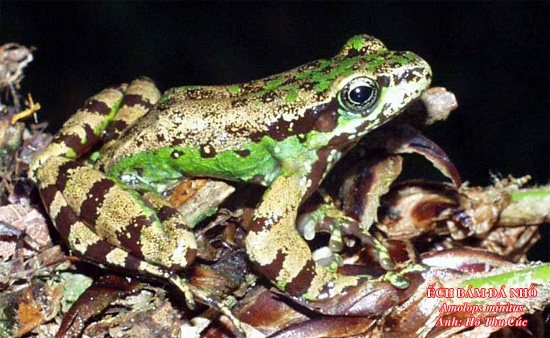| Citation |
IUCN SSC Amphibian Specialist Group 2017. Amolops minutus (errata version published in 2018). The IUCN Red List of Threatened Species 2017: e.T159250A126406905. http://dx.doi.org/10.2305/IUCN.UK.2017-2.RLTS.T159250A85572028.en. Downloaded on 08 May 2019. |
Description |
Geographic Range
NATIVE
Extant (resident)
Viet Nam
Possibly Extant (resident)
China
NUMBER OF LOCATIONS
5
UPPER ELEVATION LIMIT
2,400 metres
LOWER ELEVATION LIMIT
2,050 metres
UPPER DEPTH LIMIT
LOWER DEPTH LIMIT
Geographic Range in detail
ESTIMATED AREA OF OCCUPANCY (AOO) (KM²)
CONTINUING DECLINE IN AREA OF OCCUPANCY (AOO)
EXTREME FLUCTUATIONS IN AREA OF OCCUPANCY (AOO)
ESTIMATED EXTENT OF OCCURRENCE (EOO) (KM²)
2383
CONTINUING DECLINE IN EXTENT OF OCCURRENCE (EOO)
EXTREME FLUCTUATIONS IN EXTENT OF OCCURRENCE (EOO)
CONTINUING DECLINE IN NUMBER OF LOCATIONS
EXTREME FLUCTUATIONS IN THE NUMBER OF LOCATIONS
RANGE DESCRIPTION
This species is known only from 2,050–2,400 m Asl on Mu Hum Mountain, Lai Chau Province, northern Viet Nam (Orlov and Ho 2007). This is unlikely to represent the actual limits of the species range as similar habitat and elevations to those in its known locality occur in adjacent high-elevation parts of Lao Cai Province in Viet Nam and a small section of Yunnan Province, southern China. Further surveys in these areas may uncover its presence there, therefore its range has been projected beyond known sites to include areas of suitable habitat. The species estimated EOO is 2,383 km2, which represents five threat-defined locations.
Population
CURRENT POPULATION TREND
Decreasing
NUMBER OF MATURE INDIVIDUALS
POPULATION SEVERELY FRAGMENTED
CONTINUING DECLINE OF MATURE INDIVIDUALS
Population in detail
EXTREME FLUCTUATIONS
NO. OF SUBPOPULATIONS
CONTINUING DECLINE IN SUBPOPULATIONS
EXTREME FLUCTUATIONS IN SUBPOPULATIONS
ALL INDIVIDUALS IN ONE SUBPOPULATION
NO. OF INDIVIDUALS IN LARGEST SUBPOPULATION
DESCRIPTION
Nothing is known about the size or trends of this species population except that it has been detected in only one survey and was described from 13 individuals (Orlov and Ho 2007). Population declines are expected for this species due to the effects of historic burning, agriculture (Nguyen and Harder 1996), tourism (Rowley et al. 2013), and possibly climate change (Rowley et al. 2013, Foster 2001).
Habitat and Ecology
SYSTEM
Terrestrial, Freshwater (=Inland waters)
HABITAT TYPE
Wetlands (inland), Forest
GENERATION LENGTH (YEARS)
CONGREGATORY
MOVEMENT PATTERNS
Not a Migrant
CONTINUING DECLINE IN AREA, EXTENT AND/OR QUALITY OF HABITAT
Yes
Habitat and Ecology in detail
HABITAT AND ECOLOGY
This species is associated with cascade streams in primary montane mixed forest and has been observed exclusively on rocky outcrops and vegetation along the stream banks (Orlov and Ho 2007). Reproduction presumably occurs around April-May, as males have been heard calling at this time (Orlov and Ho 2007). Much of the species reproductive biology is unknown, however it presumably breeds in streams by larval development, as with other Amolops for which the reproductive strategy is known. This species has not been observed in disturbed areas, but the quality of habitat within parts of its range appears to be in decline due to past fire, agriculture (Nguyen and Harder 1996) and tourism (Rowley et al. 2013).
CLASSIFICATION SCHEME
Habitats Suitability Major importance
1. Forest 1.9. Forest - Subtropical/Tropical Moist Montane Suitable Yes
5. Wetlands (inland) 5.1. Wetlands (inland) - Permanent Rivers/Streams/Creeks (includes waterfalls) Suitable Yes
Threats
Residential & commercial development
Tourism & recreation areas
Agriculture & aquaculture
Annual & perennial non-timber crops
Natural system modifications
Fire & fire suppression
Climate change & severe weather
Temperature extremes
Threats in detail
THREATS
The historic burning and subsequent ecosystem conversion of some highland areas in this part of Viet Nam to agricultural land, which are thought to have been previously covered in forest (Nguyen and Harder 1996), may have disturbed this species. Current agricultural pressures include a cardamom farm, which is causing declines in the quality of its habitat (T. Nguyen pers. comm. December 2015). Habitat degradation associated with tourism is ongoing in this part of northern Viet Nam (Rowley et al. 2013) and the construction of a cable car from Sa Pa to the summit of Mount Fansipan (T. Nguyen pers. comm. 2015) may affect the species. This species restriction to high altitudes is likely to present an issue as tropical montane forests are expected to be particularly prone to alteration by climate change (Rowley et al. 2013, Foster 2001).
CLASSIFICATION SCHEME
Threats Timing Stresses Scope Severity Impact score Invasive species Virus
1. Residential & commercial development 1.3. Tourism & recreation areas Ongoing
1. Ecosystem stresses 1.2. Ecosystem degradation
2. Species Stresses 2.2. Species disturbance
Unknown Unknown Unknown
2. Agriculture & aquaculture 2.1. Annual & perennial non-timber crops 2.1.2. Small-holder farming Ongoing
1. Ecosystem stresses 1.1. Ecosystem conversion
1.2. Ecosystem degradation
2. Species Stresses 2.2. Species disturbance
Unknown Unknown Unknown
7. Natural system modifications 7.1. Fire & fire suppression 7.1.1. Increase in fire frequency/intensity Past, Unlikely to Return
1. Ecosystem stresses 1.1. Ecosystem conversion
1.2. Ecosystem degradation
2. Species Stresses 2.1. Species mortality
2.2. Species disturbance
Unknown Unknown Past Impact
11. Climate change & severe weather 11.3. Temperature extremes Ongoing
1. Ecosystem stresses 1.1. Ecosystem conversion
2. Species Stresses 2.1. Species mortality
2.2. Species disturbance
|

